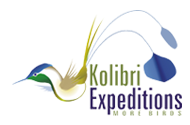The wild Heath River marks the remote Amazon-region border between Peru and Bolivia. Bordering two radically different ecosystems of rainforest and lowland savannah, it runs through the heart of the Tambopata-Madidi reserve areas of Peru and Bolivia, a vast and largely inaccessible wilderness totalling more than 13,700 sq. km./5,290 sq. miles.
Little has changed on this river since the American doctor Edwin Heath first explored and named it in the 1880s, and the eccentric English explorer Colonel Fawcett formally surveyed the far-away frontier in 1910. Traveling there today is like going back to a time before cars and roads were invented.
Heath River Wildlife Center is the only eco-lodge on this river. And it offers the world's only large macaw clay lick reachable in half a day from a jetport with daily connections to the outside world.
Only ten minutes by boat from the lodge, a comfortable floating hide just 30m/100ft from the lick allows us to witness one of nature’s most spectacular displays – a tumultuous gathering of brightly-colored macaws and parrots. Visitors have seen up to 260 macaws there at one time, which makes it one of the top five of the world's 100 known licks.
The lodge also offers an array of options almost too numerous and varied to be taken in on one visit. We can walk through the abrupt and astonishing transition between two radically different ecosystems, on the trail to open lowland savannah of the Pampas del Heath. Here the rainforest suddenly melts away, offering a startling, open vista reminiscent of East Africa -- an excursion that also takes in a rare nesting site frequented by hundreds of Red-bellied and increasingly endangered Blue-and-yellow Macaws.
On other outings we can spot wildlife and learn the ways of the forest, along the lodge’s extensive and lightly-used trail network, and perhaps stake out a hide-platform on one of the lodge’s mammal clay licks, in search of an elusive Lowland Tapir, the Amazon’s largest mammal. We can visit the abundant birds and monkeys of Cocha Moa, as we paddle by canoe on this secluded oxbow lake.

By night we can spot caiman (a kind of Amazonian alligator), on the riverbanks. By day we can travel upriver to the limits of navigation, and float stealthily downstream with the engine off, spotting birds and monkeys, and hoping to score a stellar wildlife encounter with a Jaguar on the beach, or a Lowland Tapir swimming across the river.

The lodge itself offers a small, comfortable and intimate environment, built of environmentally-sound local materials, such as “driftwood” mahogany, and palm-thatch, with just ten double (or triple) private bungalows, with private bathroom/toilets and hot showers, and a spacious, high-roofed dining, bar and lounge area.
Now Heath River Wildlife Center offers a new attraction a double platform in a big tree that offers you the chance to admire birds, monkeys and also a nice landscape.
